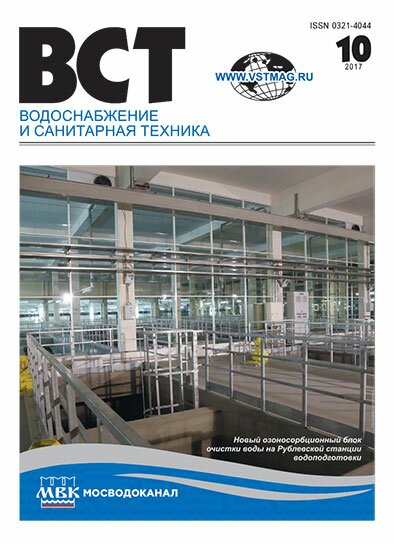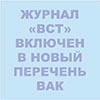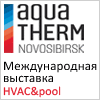|

Number 10 / 2017
To download all number in format PDF (in Russian)The further text is accessible on a paid subscription.
For authorisation enter the login/password.
Or subscribe
Number maintenance (pdf) (doc)
Number abstract (doc)
Literature lists to articles (doc)
|
bbk 000000
UDC 621.175.3:627.81
Ignatenko G. K., Kuz'min Vasilii Vasil'evich, Vinogradov A. Iu.
Microclimate in a heat sink of a nuclear power plant and its performance
Summary
The results of assessing the interaction of a heat sink at a nuclear power plant with the environment are presented. The impact of the microclimate changes on the performance of the heat sink is substantiated. Heat emissions into the environment from evaporation, convective and radiant heat fluxes as well as climatic indicators: temperature and pressure of saturated steams, wind speed (at the weather cock height), total cloud cover, aggregate values of average monthly and average annual precipitation, number of foggy days were considered as basic performance indicators. Routine observation series for 20 years (1990–2010) taken from the hydrometeorological survey technical reports at the Smolensk weather station located at the distance of 144 km from the Smolensk nuclear power plant as well at the Ekimovichi meteorological station (7 km from the Smolensk nuclear power plant) and at the meteorological station of the Smolensk nuclear power plant made the basis of the analyzed data base. The assessment of the performance indicators of the heat sink was carried out according to the nuclear power plant process design (RD 153-34.2-21.144-2003). For the given geotechnical facilities three options of the conditions determined by the meteorological data obtained at the meteorological stations of the Smolensk nuclear power plant, Ekimovichi and Smolensk were considered. The impact of the microclimate was determined by the difference in the heat loss parameters: heat release into the environment from evaporation and convective heat exchange. The analysis of the calculations of the seasonal thermal conditions of the heat sink showed their sensitivity to the microclimate changes and seasonal behavior; this fact shall be taken into consideration when undertaking commitments to increase the electric power generation.
Key words
атомная электростанция , водоем-охладитель , конвективный и лучистый теплообмен , испарение , гидрометеорологические наблюдения
Read more ...
|
bbk 000000
UDC 556.551:504.5
Mediankina M. V., Sokolova S. A., Oganesova E. V., Trigub A. G., Dmitrieva E. S.
On the problem of establishing the standards of the water quality in fishery waters
Summary
Current problems of establishing pollution limits for fishery waters have been considered. The core objectives of regulating the quality of water bodies in the Russian Federation are highlighted. A detailed comparative description of sanitary-hygienic (MPCsan) and fishery waters (MPCfishery) water quality standards is presented; the similarities and differences in establishing the given standards are shown. In the process of developing fishery and sanitary-hygienic standards the following issues are considered: the threshold concentration (the lowest concentration that produces an adverse effect both on the quality of habitat of an organism and on the organism itself); the lowest no observed adverse effect concentration (the lowest concentration that does not affect the habitat and organism throughout the life). The experimental validation of MPCfishery is an overall system of comprehensive (toxicological, hydrochemical, organoleptic etc.) tests of the chemical agent using the representatives of all aquatic organisms groups (from bacteria to fish) including producers, consumers, decomposers and various life-forms of aquatic organisms (plankton, nekton, benthos). The MPC value of a pollutant is the lowest no observed adverse effect concentration for one of the trophic level links (plankton, nekton, benthos organisms, fish as well as hydrochemical and organoleptic water quality parameters can be limiting links). MPCssan ensure water quality safe for human life and activities, MPCsfishery are the only environmental requirements that ensure the conservation of ecosystems of fishery waters. The expediency, need and demand for establishing regional regulations in the light of the actual situation in certain water bodies has been considered separately.
Key words
pollutants , water object , рыбохозяйственные и санитарно-гигиенические нормативы , тест-объект , лимитирующее звено , региональное нормирование
Read more ...
|
bbk 000000
UDC 628.112.2
Tsymbalov A. A.
Overhaul period of water well rehabilitation
Summary
Annual construction of water wells, operation and maintenance of newly step-out wells built as back as in the Soviet era demands arranging up-to-date engineering service of these assets. Therefore, the development of advanced methods of well repair in Russia has been a critical task. Based on the regional experience it is shown that maintaining the well flow rate in the process of operation is provided by routine maintenance works. The main factor for repair and maintenance works is incrustation of the filtering well part that affects the safe yield and reduces the well flow rate. In order to maintain the design capacity a new source shall be developed or special repair works shall be carried out to restore the original capacity. The well recovery expenditures can make 25–30% of the cost of a new water intake construction. The right choice of the repair method and overhaul period determines the service time and life cycle of the well. On the basis of the regional practice the approaches to solving the well decolmatation problem are formulated. The overhaul period for the rehabilitation of colmatated wells are recommended.
Key words
water well , colmatage , методы регенерации , repair and rehabilitation operations , межремонтный период , жизненный цикл скважины
Read more ...
|
bbk 000000
UDC 628.35
SHVETSOV V. N.
On the criticism of the NII VODGEO method of designing
biological wastewater treatment facilities with nutrients removal
Summary
The analysis of the critical notes published in the article by Ph. D. (Engineering) D. A. Danilovich and Engineer A. N. Epov «Comparative analysis of the methods of designing biological wastewater treatment facilities with nitrogen removal» in which the opponents make the following statements: the NII VODGEO method is «manual» and simplified, cannot be considered as mathematical model; the specific nitrification rate parameter cannot be used in calculations; the effect of temperature and other factors are not taken into account; «simplified» equations of enzyme kinetics cannot be used for nitrification-denitrification processes because of the inadmissible distortions under the impact of factors that these equations do not take into account; sludge age is determined by the effluent quality regardless of the pollutant concentration in the incoming wastewater; in sludge growth calculations sludge age shall be used; the residual concentration of a substance (in effluent) does not depend on its initial concentration; aeration tank calculations shall be based on sludge age is presented. Based on the detailed analysis of the comments and statements of the opponents their inconsistency and lack of proof is shown. It is proved that not a single substantial fact damaging the NII VODGEO method has been mentioned in the article, and the conclusions made by the authors are unfounded and unsubstantiated. The conclusion is made that the availability of a reliable and approved national calculation method will provide for restricting the unsubstantiated use of inadequate, untested calculation methods; eliminating unjustified construction and upgrade overpricing, uncontrolled engaging of untested foreign inventions in the projects; reducing the level of corruption in this field; implementing correctly the developed best available technologies in domestic practice. It is noted that up to now the calculation method included in SNiP 2.04.03-85 has been the only opportunity for the experts to design and control the facilities for municipal and industrial wastewater biological treatment. Consequently, improving and updating a universal, scientifically grounded and field-proven domestic method of designing the facilities for municipal and industrial wastewater biological treatment with regard to the nutrients removal has been a crucial and pending task. The attention is called to the need of urgent restoration of the expert competency, the revival of the Russian scholarly traditions on the basis of the immense scientific and practical capacity established by our predecessors.
Key words
wastewater , biological treatment , nitrification , denitrification , nutrients removal , возраст активного ила , расчет сооружений
Read more ...
|
bbk 000000
UDC 628.54
Sazonov D. V.
Influence of the pump type on the parameters of the pneumatic-hydraulic aeration system in flotation apparatus
Summary
Flotation has been one of the efficient water treatment technologies. Flotation treatment is based on small gas bubbles generated by different methods, pneumatic-hydraulic, in particular. A case is considered of air feeding before the pump and subsequent water-air mixture passing through the aerator, and air being broken to small bubbles. Possible operation in the presence of air determines the choice of self-priming pumps (centrifugal and vortex). Experiments were carried out on determining two of the most important aeration parameters: bubbling rate and average size of generated air bubbles that determine the efficiency of water flotation treatment. Based on the data obtained it is shown that in most cases centrifugal pumps have the advantages: considerable part of the air entering the pumps is dispersed at the outlet of the aerator to 30–100 μm bubbles; whereas in case a vortex pump is used air bubbles of more than 200 μm size are generated which is ineffective for water flotation. It is stated that for some wastewater types the use of vortex self-priming pumps can be more reasonable.
Key words
water treatment , centrifugal pump , aeration system , пневмогидравлическая флотация , интенсивность аэрации , размер пузырьков воздуха
Read more ...
|
bbk 000000
UDC 628.336.4
Smirnov Aleksandr Vladimirovich, Zinchenko D. B., Badulin R. V.
Typical engineering solutions of a wastewater sludge
mechanical dewatering plant
Summary
An illustration of a comprehensive typical solution is presented for the construction of a wastewater sludge mechanical dewatering plant based on filter press use for wastewater treatment facilities. Choosing the method of wastewater sludge treatment has been a complicated engineering task that demands special research and experiments at simulated or operating wastewater treatment facilities. Herewith the sludge dewatering properties, dewatering equipment type and cost, as well as the technology of the subsequent sludge handling with account of sludge utilization shall be taken into consideration and specified. The advantages of new construction compared to the upgrade of the existing buildings, networks, equipment are shown. Two of the typical projects are presented – with the use of two and three filter presses. The developed engineering solutions provide for the shortened timescales of project design and cost. The typical projects have been executed with the use of advanced 3D-designing tools that provide for the visualization of the building, equipment and utility systems already at the design stage of the future wastewater sludge mechanical dewatering plant.
Key words
wastewater , centrifuge , filter-press , sewerage treatment facilities , механическое обезвоживание осадков , типовой проект
Read more ...
|
bbk 000000
UDC 628.1/2:628.147.2
Kalmykov A. A.
Utilities network systems: operation experience and practical proposals on development
Summary
Water supply and wastewater disposal systems in the most of the big Russian cities for more than hundred years already have been providing for public water supply and wastewater disposal and treatment which are one of the most significant blessings of civilization. At present assessing the situation with the water supply safety and determining the vector of development with account of the gained experience including overcoming negative trends that reflect different processes in the branch have been tasks of primary importance. The attempt to summarize the experience of operating water distribution networks and evaluate the current state of the industrial relations and water and wastewater services maintenance forms as well as of the prospects for the development of network systems as part of the whole branch is presented. The apparentness of the pending problems and their structural analysis using the example of solving the applied problems of reducing network accidents show the need to formulate the concept of the branch development. Only the extensive discussion and engagement of all the stake holders – business, scientific community, managers of public utilities, regional and federal officials will provide for solving the problems in the branch that have become more acute lately and that have made the residents of the Russian regions suffer most notably.
Key words
reduction in accident rate , надежность сетей водоснабжения и канализации , концессионное соглашение , концепция развития водопроводно-канализационного хозяйства
Read more ...
|
bbk 000000
Погружные насосы «сухой» установки для бесперебойной работы КНС
Аннотация
Канализационные насосные станции строятся там, где транспортировка сточных вод самотеком невозможна или когда необходимо искусственное увеличение скорости потока, чтобы избежать уменьшения эффективного сечения трубопровода и заиливания.
Read more ...
|
|











